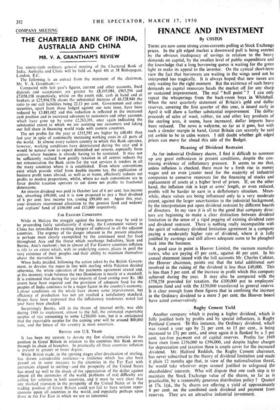FINANCE AND INVESTMENT
By CUSTOS
THERE are now some strong cross-currents pulling at Stock Exchange prices. In the gilt edged market a downward pull is being exerted by the obvious inadequacy of savings in relation to the heavy demands on capital, by the swollen level of public expenditure and the knowledge that a long borrowing queue is waiting for the green light to make its appeal to the investor. On the cynical short-term view the fact that borrowers are waiting in the wings need not be interpreted too tragically. It is always hoped that new issues are only waiting for the right moment. But the existence of such heavy demands on capital resources heads the market off for any sharp or sustained improvement. The real " bull point " ? I can only repeat the whisperings from the back-room boys in Whitehall. When the next quarterly statement of Britain's gold and dollar reserves, covering the first quarter of this year, is issued early in April it will show a further substantial improvement. The dollar proceeds of sales of wool, rubber, tin and other key products of the sterling area, it seems, have increased, dollar imports have been reduced. The news is welcome, so far as it goes, but with such a slender margin in hand, Great Britain can scarcely be said yet awhile to be in calm waters. I still doubt whether gilt edged prices can move far ahead this side of the Budget.
Meaning of Dividend Restraint
As for industrial Ordinary shares, I find it difficult to summon up any great enthusiasm in present conditions, despite the con- tinuing evidence of inflationary pressure. It seems to me that, unless inflation is checked, there must be a fresh rise in money wages and an even 'greater need for the majority of industrial companies to conserve resources for the financing of stocks and replacement of assets at a higher level of prices. If, on the other hand, the inflation risk is kept at arms' length, or even reduced, profits will be harder to earn in a deflationary situation. Mean- while, share values are being influenced only to a very moderate extent, against the larger uncertainties in the industrial background, by the interpretation put upon dividend restraint by different boards of directors. In my view it is all to the good that company direc- tors are beginning to -make a clear distinction between dividend limitation in the sense of a rigid pegging of existing dividend rates and dividend restraint. There is nothing really incompatible with the spirit of voluntary dividend limitation agreement in a company paying a moderately higher rate of dividend, where it is fully justified by earnings and still allows adequate sums to be ploughed back into the business.
A good case in point is Hoover Limited, the vacuum manufac- turers, who are paying 45 per cent., against 40 per cent. In his annual statement issued with the full accounts Mr. Charles Colstan, the Hoover chairman, points out that the total additional sum involved in the raising of the dividend is less than £40,000. This is less than 5 per cent of the increase in profit which this company achieved during the year. It may also be compared with the £758,258 provided for taxation, the £100,000 put to employees' pension fund and with the £150,000 transferred to general reserve. It is clear enough from these figures that in confining the increase in the Ordinary dividend to a mere 5 per cent. the Hoover board have acted conservatively.
Rugby Cement Yield
Another company which is paying a higher dividend, which is fully justified both hy profits and by special influences, is Rugby Portland Cement. tWthis instance, the Ordinary dividend, which was raised a year ago by 24. per cent, to 15 per cent., is being increased to 17+ per cent., and once again it is flanked by a 5 per cent. tax-free payment out of capital reserves. Profits for 1949 have risen from £356,000 to £396,000, and despite higher charges for depreciation and taxation there is ample cover for the increased dividend. Mr. Halford Reddish, the. Rugby Cement chairman, has never subscribed to the theory of dividend limitation and made it plain 12 months ago that, in view of the nationalisation threat, he would take whatever steps seemed justified to safeguard the shareholders' interests. Who will dispute that one such step is to maintain the Stock Exchange value of the shares, so far as is practicable, by a reasonably generous distribution policy ? Quoted at 17s. lid., the 5s. shares are offering a yield 'of approximately 8 per cent. on the combined cash dividend and payment from reserves. They are an attractive industrial investment.


































 Previous page
Previous page